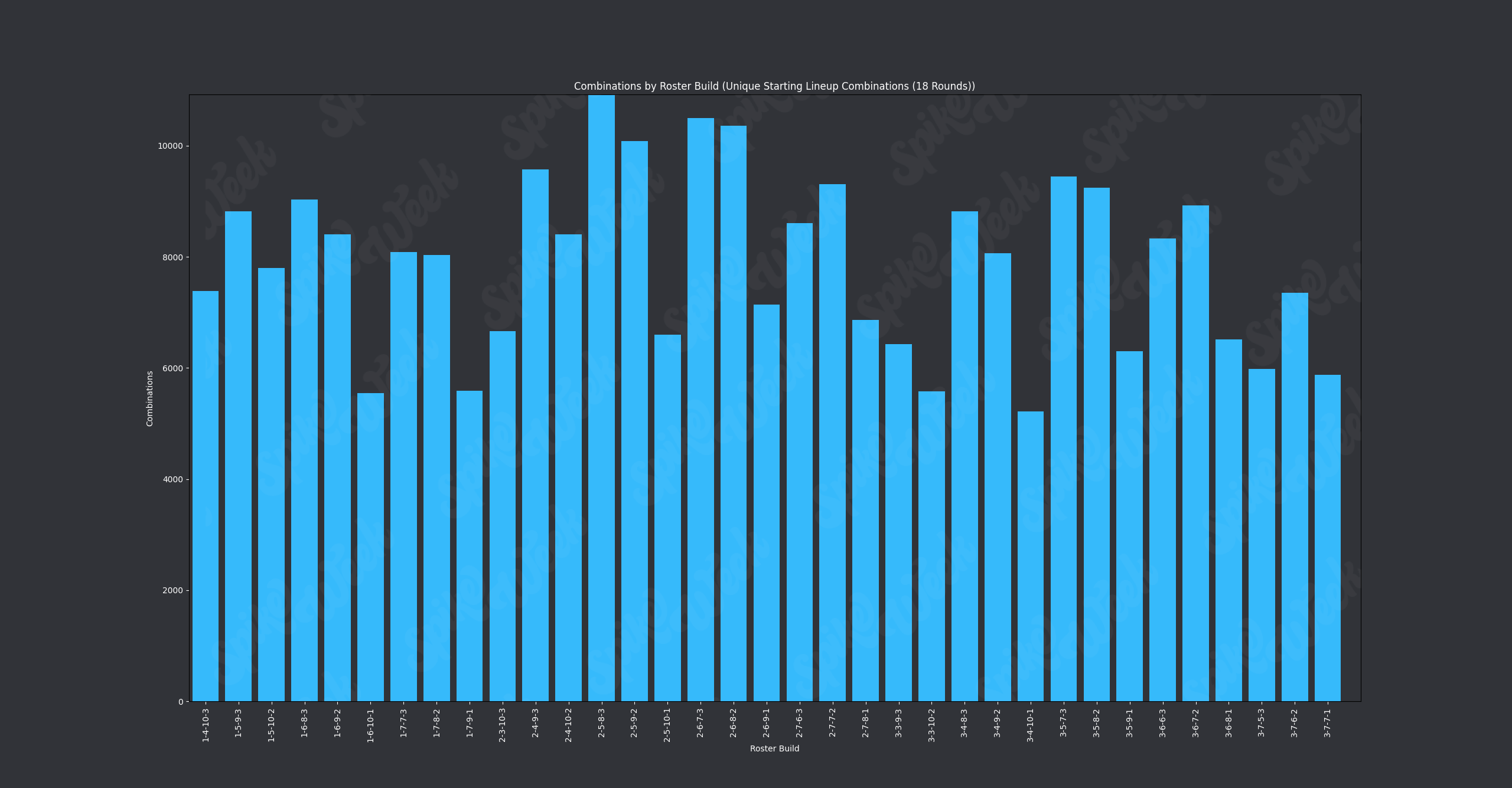Robust ‘onesie’ (AKA QB and TE where we only play one of that position in our starting lineup) strategies like 3QB and 4TE are all the rage right now, but in this article I’m going to explain why those builds are actually sub-optimal if your goal is to win $3M in a 677,376 person tournament, such as Best Ball Mania 4.
Best Ball Tournaments & Roster Construction Combinatorics
Every best ball team is an 18 dimensional object (each dimension being a roster spot). The total contest can be imagined as an n-dimensional space that can hold all of these 18 dimensional objects. The total size of the space cannot be fully occupied by the total number of entries, far from it. There are teams that clump together in certain areas of the space, because they are similar in some way (similar players, stacks, pod texture etc.). The outcome that determines the winner is a random coordinate in the space, and the teams that exist closest to that coordinate have the best chance of capturing that outcome based on their proximity. With all else remaining equal, we should aim for our teams to exist in areas of this space that maximize the number of coordinates where our team is the closest relative to all other teams.
The first instinct you might have is to ask, “how do I get unique and make sure my teams exist in lower density localities?” While I believe there is value in pursuing this line of thought, and there are ways to pursue it without sacrificing EV, this topic will not be the focus of this article.
Instead, we will focus on on a concept that’s easier to execute: occupying more space. I’d like to draw an analogy between a best ball tournament and rebounding a basketball. In this analogy the players in our basketball game are best ball teams, and the basketball is the event that determines the winner of the tournament. Because the shot we are rebounding is highly random, there could be value in standing among the many other players near the hoop, or it could be better to wait off in the wings. To quote best ball thought leader David Kitchen, “we just don’t know.” What we could say definitively helps in our pursuit to rebound basketballs is our height. Who hasn’t wished they were a little bit taller (or wished they were a baller, for that matter)? So what if there was some action we could take to make ourselves taller? Fortunately for our best ball teams, there’s no need to chug milk, wear lifts, or hop onto an inversion table. We just need to understand the impact that structure has on the “height” of our teams.
Below is a chart of different roster constructions and the number of unique possible starting lineups each construction can field in a single week (this is specific for Underdog roster settings). The X-axis lists the specific roster construction; the Y-axis is the number of unique starting lineups.
.
Top 5 roster constructions by unique lineup combinations (QB-RB-WR-TE):
- 2-5-8-3 (10,920 possible unique starting lineup combos)
- 2-6-7-3 (10,500)
- 2-6-8-2 (10,360)
- 2-5-9-2 (10,080)
- 2-5-7-4 (9,800—curse you and your 4 TEs, Dan Zack, you win this one.)
Bottom 5 roster constructions by unique lineup combinations (4 QB rosters excluded):
- 3-7-7-1 (5,880)
- 1-7-9-1 (5,586)
- 3-3-10-2 (5,580)
- 1-6-10-1 (5,550)
- 3-4-10-1 (5,220)
If you needed me to tell you 3-4-10-1 was a poor roster construction, my deepest condolences to your current best ball portfolio. Our top 5 constructions by number of unique combos are commonly used by the field, as they should be. But let’s take a look at some commonly used constructions that are sacrificing a substantial number of combos:
- 3-4-10-1 (5,220)
- 3-5-9-1 (6,300)
- 2-5-10-1 (6,600)
- 3-7-6-2 (7,350)
- 3-4-9-2 (8,064)
We’re almost out of Chart Town, but the last group of constructions I want to look at are less commonly used constructions that do relatively well with their combo numbers:
- 1-6-8-3 (9,030)
- 1-5-9-3 (8,820)
- 1-6-9-2 (8,400)
It’s clear that there are roster constructions that provide a substantial increase in the total number of possible unique starting lineup combinations. But not all starting lineups are created equal. Some combinations will inherently be more valuable than others. We can assume the lineup where you’re starting your QB1, RB1-2, WR1-4, and TE1 has a higher median projection than the lineup that starts QB2, RB4-5, WR4-8, and TE2. However, the second lineup DOES sometimes hit. The future of best ball will be simulating weekly outcomes for all potential lineup combinations and estimating the likelihood of a top 5%, 1%, and 0.1% outcome in a single week. In the absence of those sims, I’ll make some assumptions. The difference in top 5% outcome probability of the worst performing lineup combinations is extremely marginal (for example the worst projecting 1,000 starting lineups from 2-5-8-3 do not project much differently than the worst 1,000 starting lineups from 3-6-7-2). I believe quantity trumps quality, especially given the highly variant nature of football. So when choosing between which team we want rebounding our basketball, give me the taller guy.
This analysis has been one of the factors that has contributed to my strong preference for 2 QB builds this season. It’s also illuminated for me that solo elite QB builds may be more viable than I initially thought, especially given the current QB prices. Some solo elite QB builds have a higher number of total unique lineup combinations than 3 QB builds, and when we consider that the big 3 elite QBs have historically had a relatively low downside deviation compared to their positional counterparts, I can certainly see the path for a solo elite QB team to be viable in large field best ball tournaments.
I believe that 3 QB builds are currently being over utilized by the field. In Best Ball Mania 3, 3QB builds were used a total of 160,473 times, or 35.57% of the time. Best ball drafters are finding themselves less and less comfortable with their 2 QB teams and are hoping that tacking on a 3rd late QB is a panacea for what they view as untenable prices for the top end QBs. While adding a 3rd QB can often times increase playoff advance rate, and has historically, it also has consistently decreased Semi-Finals and Finals advance rates for both 2021 and 2022. Here’s what a quick dive into the Rotoviz roster construction explorer tells us:
For teams that drafted their QB1 after round 8 (I chose round 8 as our cut off point because I assume more players are comfortable building 2QB teams if they get an earlier QB) –
2021
2 QB teams
- 15.3% playoff advance rate
- 1.68% Semi-finals advance rate
- 0.10% finals advance rate
3 QB teams
- 14.4% playoff advance rate
- 1.19% Semi-finals advance rate
- 0.06% finals advance rate
2022
2 QB teams
- 15.3% playoff advance rate
- 1.54% Semi-finals advance rate
- 0.11% finals advance rate
3 QB teams
- 17.4% playoff advance rate
- 1.34% Semi-finals advance rate
- 0.10% finals advance rate
We’re dealing with small sample size here, as this is only 2 BBM tournaments. However the story the data is telling us is consistent with my hypothesis: 3 QB teams hurt your chances in the playoff rounds. Couple that with the fact that adding a 3rd QB doesn’t necessarily increase our playoffs advance rate (as seen in 2021), and I’m much less keen on drafting 3 QB teams.
I think a good way of framing my case against 3 QB teams is this:
By drafting a 3rd QB, you’re denying yourself the upside of a 2 QB roster that could have potentially been just fine without the 3rd QB. That late round WR, RB, or even TE that you unnecessarily omitted from your roster can be massively valuable, especially in the playoff weeks. Pat Kerrane touched on this in his “Draft Like You Have a Time Machine” article, highlighting the importance of production from late round skill position players.
Another way of framing this problem is to view each best ball roster as a player pool that we are using to construct DFS lineups. However, in this contest, our maximum entries are not limited to 150. Instead, they are limited to the number of possible unique combinations that you can create from your player pool. There are certainly some lineup combinations that we can say have lower probability of of hitting a top 5% outcome in a single week, like lineups with a TE in the FLEX. Those lineups do have a non-zero chance of a top 5% weekly outcome though, and therefore they add some non-zero value to our team. In this hypothetical DFS contest you would want to tailor your player pool to maximize the probability of a top 5% outcome (or perhaps 6.25% if you were playing a hypothetical winner take all 16 man contest) and a top 0.23% outcome (if you were playing in a hypothetical winner take all 441 man contest).
This article is not to say that we must only select roster constructions that maximize the number of possible starting lineup combinations, but I do believe this is certainly a factor that should be considered when constructing teams. There are absolutely situations where a 3rd QB increases the EV of a team via advance rate boost enough to offset the loss of EV from the decrease in top 6.25% single week outcome frequency. This game is so highly variant that you may never realize any edge you hypothetically gain from executing this strategy. I personally just want to get my money in the best that I can.




